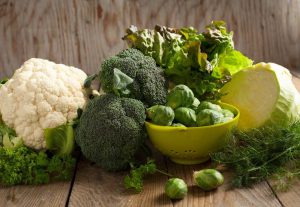
Leaves outside the windows at the Block Center have turned autumnal shades of red, orange and yellow and are now tumbling from the trees, signaling the arrival of the cooler season. And since fall is on the calendar for ovarian cancer awareness, this seems an apt time to pay attention to healthy fall foods for our ovarian cancer patients (and for all of us.)
While many studies have analyzed dietary recommendations for those with breast and prostate cancers, less attention has been paid specifically to ovarian cancer. Yet a June 2017 study from Australia focused particularly on healthful diets for women with ovarian cancer. The researchers monitored survival for over 9 years of more than 800 women with an ovarian diagnosis to determine what types of food were most highly correlated with survival.
What they found: Patients with the highest fiber intake had a 41% reduction in mortality, and this was demonstrated with strong statistical significance. Additionally, eating lots of leafy green vegetables and fish was also linked with greater survival. On the other hand, patients who were eating a high-glycemic diet – that is, heavy in refined carbohydrates and sugars versus complex carbs — had a 28% increased risk of mortality. These results interestingly echo the findings of a similar but earlier dietary study of ovarian cancer patients in the Chicago area. For those patients eating the highest quantity of vegetables from the cruciferous family like cabbage, broccoli and kale, as well as yellow vegetables (think yellow squash and yellow sweet peppers) along with fresh fall fruits had significantly improved, longer survival. But conversely, women consuming red or processed meats and cow’s milk or milk products seemed to have worse survival prospects.
Of course, both studies were based on diets that women ate before they were diagnosed. Possibly, the women who were eating healthier diets may have had less aggressive tumors when they were diagnosed due to the cancer-suppressive effects of what they had routinely been consuming (meaning, green vegetables, fiber-rich whole grains and fish.) But if a healthy diet can result in a less aggressive type of tumor, we certainly would like to see similar cancer suppression after diagnosis. And most likely the women in these studies continued their good, habitual eating patterns after they had been diagnosed and begun therapy. So these findings can have strong relevance for ovarian cancer patients even following diagnosis.
While some healthy foods noted in these studies were summer specialties, it is a wide range of wonderful fall foods that definitely support dietary benefits for ovarian cancer patients. Among these are cruciferous vegetables like Brussels sprouts, cauliflower, and kale; and the good news is even fall kale seems ‘sweeter,’ less ‘peppery’ when growing in cooler, fall soil.
Importantly, demonstrated in these dietary findings was the clear, negative impact of a high-glycemic index diet on survival. Fortunately, the fall brings all the sweet, crisp and juicy apple varieties which are wonderfully low-glycemic fruits to enjoy either fresh or baked in apple pies or apple crisps and cinnamon flavored homemade apple sauce. That means you can use apples and pears in dessert recipes that satisfy your sweet tooth without compromising your recovery. Fiber was also major influence on ovarian cancer survival, and apples and pears are another good source of fiber. Additionally pumpkins, a traditional autumn food, are also first-rate sources of fiber, and can be used in sweet pumpkin pies and breads. But many pumpkin breads are high in sugar, so be cautious about them. Some recipe suggestions will follow this post for making your own non-sugar-sweetened desserts, but certainly you can find numerous no-sugar ideas online and thus not miss out on these fall and holiday treats.
There are many opportunities for a healthy autumn for ovarian cancer patients! If you would like more personal guidance please let us know so we can answer your questions.

